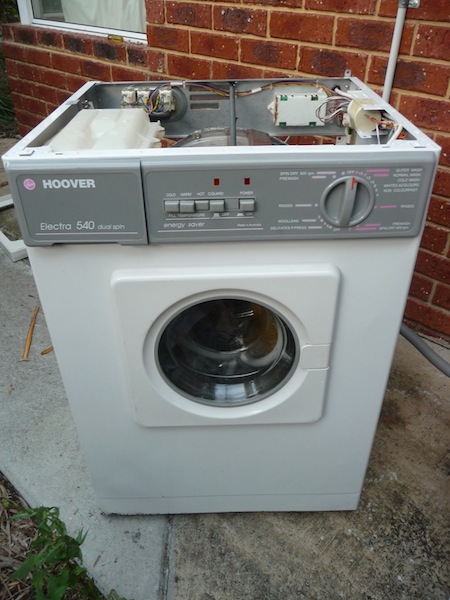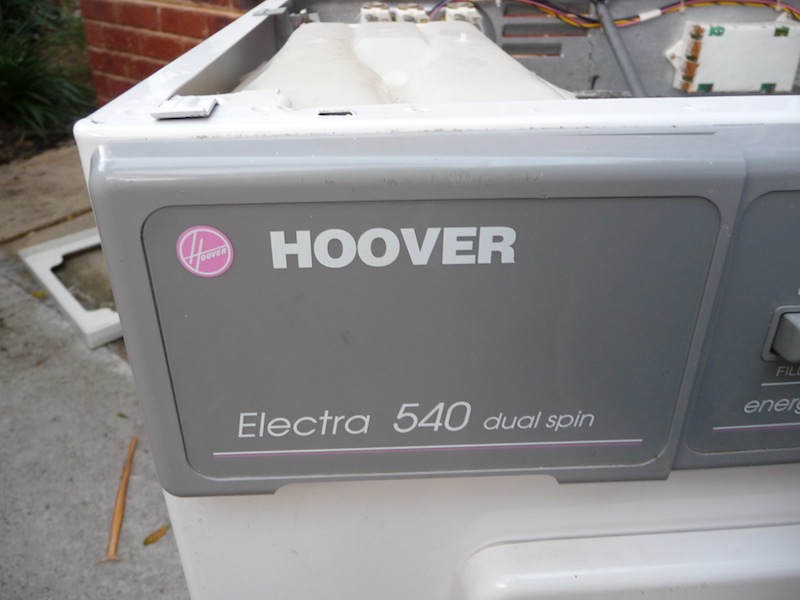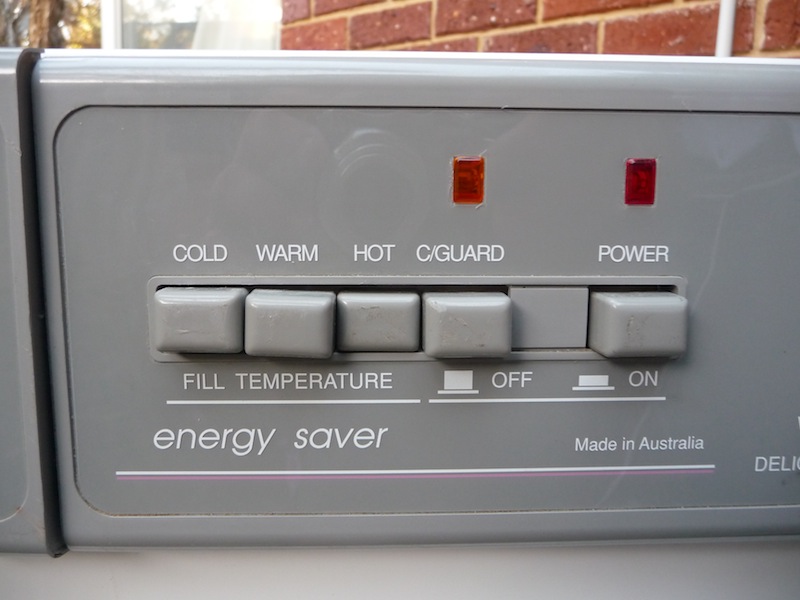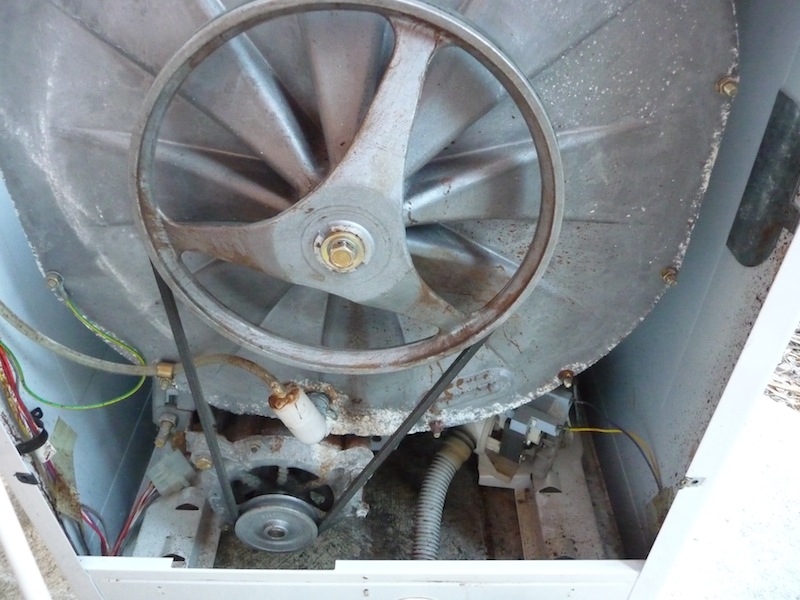|
Thread Number: 37669
New Find: Hoover Electra 540 Dual Spin - Australian F/L |
[Down to Last] |
Post# 560353 11/30/2011 at 08:24 (4,622 days old) by mattywashboy  (Perth, Western Australia) (Perth, Western Australia) |
||

Hi Guys
Well just before I was due to leave England for my flights back home this past Sunday, I was searching Perth Gumtree. I found a Hoover Electra 540 Dual Spin front loader made in Australia. I have always wanted one of these machines so despite the seller not being sure of its condition, i went ahead and organised a pick up when I arrived back home. Well today I went and grabbed it, despite slight jetlag lol I never realized how heavy these machines are! Wow, thankgod one of my housemates was casually listening to his Ipod on the front porch and offered to help me, bet he wished he never had! Haha! Well upon getting the machine to the front of my house I plugged it in and ran a dry tumble/drain/spin to see what I was facing. First thing that I found (and possibly the rest of West Australia) was that the bearings are shot, this thing growls like a starving bear... Also someone has been very heavy handed with the buttons and when I went to turn the machine off, the entire row of buttons went inside the machine. I remedied this by taking the lid off and clipping the row of buttons back into its spot. Next was the Power button would not stay in, so once again went inside (power unplugged) and secured the spring behind it so it would pop in and out as it should. Next issue, it leaks. Taking the back off and pouring some water into the drum and watching, I found it to be dripping from the back bottom of the outer tub which appears to be starting to rust and corrode. So I have a task ahead of me. Since parts appear to be available for this machine from online stores and my local appliance parts dealer, I think I will do my best to refurb this machine with new belts, bearings and door rubber. Here come some pictures. My question is there anyway to solve the leaking without replacing the outer tub, just in case I cannot source one? Anyway, heres the pics :-) Matt 
| ||

|
Post# 560356 , Reply# 1 11/30/2011 at 08:32 (4,622 days old) by mattywashboy  (Perth, Western Australia) (Perth, Western Australia) |
||

Soap Drawer frontage. These machines were unique inside the drawer. Instead of having a Prewash and Main Wash side, you have a side for Cold water washes only on the left and then Hot and Warm washes on the right. Fabric Conditioner dispenser is in the center as on all Hoover automatics that offered one.

| ||
| Post# 560357 , Reply# 2 11/30/2011 at 08:34 (4,622 days old) by HotpointFan (United Kingdom) | ||
mattywashboy | ||
Post# 560358 , Reply# 3 11/30/2011 at 08:37 (4,622 days old) by mattywashboy  (Perth, Western Australia) (Perth, Western Australia) |
||

Control Buttons
Hot, Warm, Cold. Nice and basic. In later more 'deluxe' models, there was a button in the space between the C/Guard and Power buttons that activated a Heater. This turned on during the wash phases and would heat during the wash time. So if you ran a Cold 15 minute Super Wash you could end up at the end with it reaching 40-50 degrees maybe? If you selected Hot you could almost end up with 90, so i'm told. The Crease Guard button from memory stopped all action at any point in the washing and rinsing cycles. Just to prevent creasing if you were leaving the machine for a period of time you could hit this button and then recommence whenever you returned home. This is what I remember from a friends machine but not certain, Ronhic you could have a better idea? 
| ||
Post# 560360 , Reply# 4 11/30/2011 at 08:44 (4,622 days old) by mattywashboy  (Perth, Western Australia) (Perth, Western Australia) |
||

Wash programme dial.
Almost identical to the top loaders of the time. The numbers indicated the number of minutes wash time. The Prewash section is the final rinse. People could use this cycle with a small amount of soap as a Prewash with a final spin then reset with more soap to a wash. Same on the top loaders only on that dial it was labeled as Prewash/Rinse as this was the deep rinse cycle after the top loaders spray rinses. The Dual Spin is basically the offering of two seperate spin speeds of 800 for cottons/normal cycles and 500 for Gentle cycles. I like the way they labeled this. Basically this machine is so easy to operate, you select your temperature and then you can select the wash by the fabric/colour or the number of minutes you want to wash for. I remember my friend always using the 4 minute Non Colourfast wash on Cold water as "this is all my clothes and towels and sheets need". Cringeworthy lol 
| ||
Post# 560361 , Reply# 5 11/30/2011 at 08:45 (4,622 days old) by mattywashboy  (Perth, Western Australia) (Perth, Western Australia) |
||
 | ||
Post# 560362 , Reply# 6 11/30/2011 at 08:46 (4,622 days old) by mattywashboy  (Perth, Western Australia) (Perth, Western Australia) |
||
 | ||
Post# 560363 , Reply# 7 11/30/2011 at 08:49 (4,622 days old) by mattywashboy  (Perth, Western Australia) (Perth, Western Australia) |
||

Inside from the back
You can see the corrosion starting to appear on the outer drum. The leak is coming from one of the nuts on the bottom of the drum, quite a steady drip, glad I tried it outside or I would have been mopping my floors for the second time today lol. Any advice and or help is welcomed and appreciated. I'm still a novice at the mechanics of washers and repairing one is a little daunting. 
| ||
| Post# 560424 , Reply# 9 11/30/2011 at 15:00 (4,622 days old) by ronhic (Canberra, Australia) | ||
Matty Ok, first things first...
- These machines have a stainless outer drum - the leak shouldn't be because of rust on the drum.... - That machine would have been made somewhere around 1992/3 - so she's nearly 20 years old
Now, to the programmer Batman....
- All Hoover front loaders made in Australia (to the best of my knowledge) could be had with a heater. It's designated by the last digit in the model number. 540 is without, but a 545 is with. - On a heater model, you can engage the heater on any cycle and it will bring the temperature up to 40c on Warm and 60c on Hot. What you end up with is determined by which temperature button you select on Electra machines, not which programme. So if you select a 10 "cold wash' but have the warm button engaged, you'll get a hot/cold incoming water mix. Have the heater engaged (if there) and it'll heat as appropriate. - A lack of an integrated pre-wash programme meant that there was no need to have hot/cold running to both drawer compartments and, when you think about it, the drawer is set up to cater for how the majority of Australians wash - in cold water.
Paul,
These are the final machines that used the Zodiac base or UK machines of a similar overall design - they are smaller than current machines (58cm wide) and they are completely different from a programme, motor point of view. These motors were new in the Electra series and extremely strong....plus they were able to do proper distributions.
Overall, they were simple where they needed to be - timer/programmes and appearance, but more advanced than some others with an up to date motor. I'm not sure if this model or the one after (which I had) went from 5 rinses to 3.
Get her going Matty or find another, preferably a 550, you won't be disappointed and they're still a good machine to use as a daily driver. | ||
| Post# 560689 , Reply# 11 12/1/2011 at 17:55 (4,621 days old) by paulc (Edinburgh, Scotland) | ||
Matt
congratulations on the "new" machine. I love the simple programme dial. I used to work with and Australian girl who grew up with a Hoover machine but was a bit baffled by the UK Hoover machine she had in a rental flat here, I had to explain what the cycles did and she did ask where the Hot, Warm and Cold buttons were. Hopefully you will get this machine up and running.
| ||
Post# 560877 , Reply# 12 12/2/2011 at 20:32 (4,619 days old) by mattywashboy  (Perth, Western Australia) (Perth, Western Australia) |
||
 | ||
| Post# 715988 , Reply# 14 11/18/2013 at 02:31 (3,903 days old) by ronhic (Canberra, Australia) | ||
 | ||
| Post# 727792 , Reply# 16 1/15/2014 at 05:50 (3,845 days old) by ronhic (Canberra, Australia) | ||
Hello Ian
...and welcome!
Given the age of the machine there are several things that could be causing the water leakage: - You may have a split door boot. This need not be a large split to let lots out either. - one of the inlet hoses to the detergent drawer could be split - the sump hose between the bottom of the machine and pump could have a split - the pump may be leaking. - the drum may be leaking - the rear seal may be leaking With the top off the machine, it's easier to check the door seal as it'll let light in through a split. If this doesn't appear to be the issue, whilst the top is off, you could run the machine through a warm fill so both water inlets (wash side) are used. Check the hoses going to the drawer. Stop the machine and unplug.... Check to see if there is any water leaking onto the floor at this point. See if you can trace it back. Turn the power back on and have it pump out/spin. Finally, move the timer to the 'prewash' setting and let it fill again. This will engage the last solenoid and the final inlet into the detergent drawer. Once you can track it back, others will be able to assist with sorting it, however, there's a link to a chap in Brisbane who's overhauled an earlier Hoover machine here in Oz. CLICK HERE TO GO TO ronhic's LINK | ||

 Comes to the Rescue!
Comes to the Rescue!